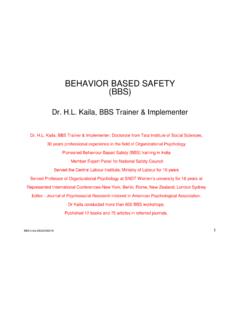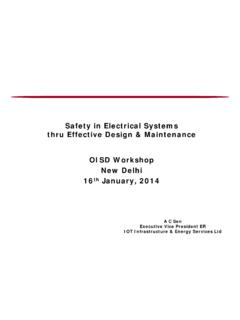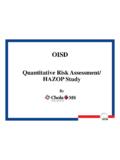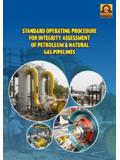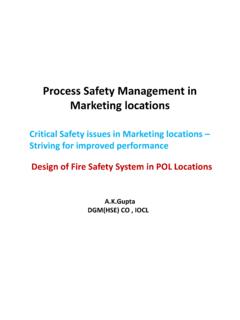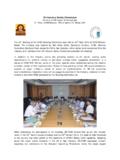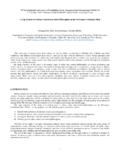Transcription of OISD
1 OISD 1 OISD 2 Guidance notes April 2012 on Petroleum and Natural Gas (Safety in offshore Operations) Rules, 2008 introduction Petroleum and Natural Gas (Safety in offshore Operations) Rules, 2008 framed under the Oilfields (Regulation and Development) Act, 1948 are meant for regulation of safety in offshore exploration, exploitation, conservation and management of petroleum and natural gas and matters connected therewith. These rules follow goal setting approach what is to be achieved rather than prescribing specific solutions.
2 Functional requirements have been given in the rules which among other things, refer to safety related issues without specifying any particular solution to be adopted. The rules have been supplemented by these guidance notes, wherever required. The guidance notes indicate possible solutions for complying with the requirements arising out of the rules. The operator can choose a solution other than those mentioned in the guidance notes as long as it fulfils the functional requirements, and is equal to or better than the solution given in guidance notes. Solution chosen by the operator shall be based on customary practice in the industry, requirements & specifications appearing in other documents such as nationally and internationally recognised industrial standards ( standards like API, ISO, OISD), codes and conventions ( MARPOL, SOLAS, ISM, MODU code etc).
3 However, evidence in form of documentation, demonstrating that solutions selected by the operator fulfil the functional requirements of the rules, shall be maintained by the operator at all times. Documentary evidence of compliance is mandated by Rule#36(5). Requirements of documentary evidence demonstrating compliance with the rules are mentioned against the rules in these guidance notes. OISD 3 Unless otherwise stated, reference to and use of the standards / Recommended Practices / Guidelines is intended to be the latest revisions and updates.
4 In case of rules having no clear-cut standards / guidelines (such as Rule-41, 43 etc), the operator himself shall define requirements and specifications for his activities and systems in order to comply with functional requirements of the rules. The operator s own defined requirements shall be binding and will constitute the basis of the supervision carried out by the competent authority. OISD has been notified as competent authority to exercise the powers and functions as stipulated in the rules vide Gazette of India 1502(E) dated 18th June, 2008.
5 OISD will carry out supervision by means of consents, investigations, verification and safety audits. Other statutory requirements that are applicable to the petroleum activities in offshore areas, for instance stipulations laid down by the Ministry of Shipping, Ministry of Environment & Forest, Ministry of Defence, Ministry of Civil Aviation, Flag State etc. are not part of these rules. In most of the rules, responsibility is placed on The licensee, the lessee, or as the case may be, the operator whereas in some of the rules it is on The operator only depending upon the requirements of the rule.
6 In the rules / sub rules where no party is mentioned, the licensee, the lessee, or as the case may be, the operator shall be responsible. Hence, the above entities are liable for penal action for contravention of the Rules. OISD 4 CHAPTER I PRELIMINARY Rule-1 Short title, extent and commencement: Sub-rule (1): The rules apply to offshore oil and gas drilling rigs and production installations and associated facilities like sub-sea production systems, Pipelines etc. Supply /support vessels and construction barges are not covered under these rules when these are outside the 500 m safety zone.
7 While inside the safety zone, the relevant Rules like 167, 168,54,55,56 shall be followed by them. Diving activities per se are covered under these rules. Seismic activities are not covered by these rules. Sub-rule (2): Date of publication of these rules in the official gazette is Rule-2 Definitions: (e): Also called SIMOPS (Simultaneous Operations). (q) & (r): The term person means a company (ies) recognised by the law as having rights and duties. (s): offshore installation includes process platform, unmanned wellhead platform, drilling rig, modular rig, FPSO, FSU, SBM etc (z): Territorial waters, contiguous zone, continental shelf and exclusive economic zone of India shall have the meaning as defined in The territorial waters, continental shelf, exclusive economic zone and other maritime zones act, 1974.
8 OISD 5 CHAPTER II PRINCIPLES RELATED TO HEALTH, SAFETY AND ENVIRONMENT Rule-3 Safe petroleum activities: This rule is a fundamental provision for the petroleum activities undertaken in the relevant waters. While planning and carrying out the activities, individual as well as collective assessment of all the safety related factors shall be made. Documentary evidence of compliance: 1. Safety Policy of the company; 2. A write up on how the company ensures that the safety policy is transmitted down the line and implemented at the installation to ensure safe petroleum activities; 3.
9 Demonstration of Management s commitment towards safety: Can be in form of periodic safety reviews/ meetings; physical visits to the installations by management. Rule-4 Set up organization: Sub-rule (1): The operator shall have organizational set up in India related to HSE matters manned by competent persons to ensure that petroleum activities are conducted in accordance with the rules. There shall be one nodal person in each organization approved by the head of the organization who will be competent to interact with OISD for regulatory compliance issues.
10 However, OISD may contact other persons in various OISD 6 departments / assets / regions of the company for technical information and records as and when required. Sub-rule (2): Competence means qualifications, training and experience to carry out their assigned work in safe manner. Documentary evidence of compliance: 1. Organogram of HSE department and its linkages in both directions, downward up to installation and upward up to the board level; 2. Competency criteria and compliance thereto of key positions like OIM, Tool Pusher, Tour pusher, Driller, Barge Engineer, Process In-charge, Maintenance in charge; 3.
